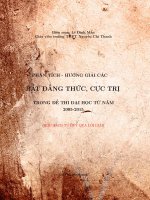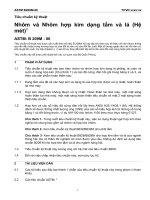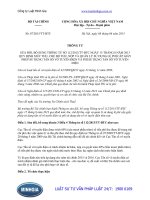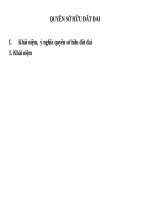Astm b 578 87 (2015)
Bạn đang xem bản rút gọn của tài liệu. Xem và tải ngay bản đầy đủ của tài liệu tại đây (70.5 KB, 2 trang )
Designation: B578 − 87 (Reapproved 2015)
Standard Test Method for
Microhardness of Electroplated Coatings1
This standard is issued under the fixed designation B578; the number immediately following the designation indicates the year of
original adoption or, in the case of revision, the year of last revision. A number in parentheses indicates the year of last reapproval. A
superscript epsilon (´) indicates an editorial change since the last revision or reapproval.
This standard has been approved for use by agencies of the U.S. Department of Defense.
1. Scope
3.1.2 The thickness of the coating shall be at least 38 µm for
soft coatings such as gold, copper, and silver, and 25 µm for
hard coatings such as nickel, cobalt, iron, and hard gold. This
is approximately equivalent to 0.6 times the length of the long
Knoop diagonal.
3.1.3 Make the indentation near the center of the cross
section of the coating.
1.1 This test method covers the determination of the hardness of metallic coatings upon various substrates. The measurements are made with the Knoop indenter under a test load
of 0.245 N (25 gf) or 0.981 N (100 gf).
1.2 This standard does not purport to address all of the
safety concerns, if any, associated with its use. It is the
responsibility of the user of this standard to establish appropriate safety and health practices and determine the applicability of regulatory limitations prior to use.
3.2 No single test load is applicable to all coatings. Use a
load of 0.245 N for soft coatings (from 50 to 300 HK) and a
load of 0.981 N for hard coatings (greater than 300 HK).
3.2.1 A load of less than 0.245 N is not recommended.
However, when the length of the diagonal is great enough at a
load of 0.245 N, which may occur for very soft coatings such
as tin and indium, a lighter load or a lower magnification shall
be specified provided the requirements of 3.3 are met. When
testing extremely hard coatings, a load greater than 0.981 N
may be used provided this is specified in the purchase order.
The Knoop hardness number decreases appreciably with loads
from 0.245 N to 0.981 N especially for the higher hardness
numbers.
2. Referenced Documents
2.1 ASTM Standards:
E384 Test Method for Knoop and Vickers Hardness of
Materials2
3. Special Requirements
3.1 In addition to the requirements listed herein, the test
method shall be performed in accordance with Test Method
E384.
3.1.1 The measurement shall be made on the cross section
with the long diagonal of the indentation parallel to the
substrate using a Knoop indenter.
3.3 Measure the length of the long diagonal to within 0.25
µm or 0.4 %, whichever is larger, at the magnification specified
in Test Method E384.
NOTE 1—When a nondestructive test is necessary, the measurement
may be made normal to the surface provided that the whole of the
indentation is clearly delineated in the field of the microscope at the
magnification specified in Test Method E384, and the coating thickness is
at least 0.7 that of the long diagonal. The outlines of the indentation must
be sharp and undistorted by any mechanical effects resulting from the
thinness of the coating such as “butterfly” fractures, etc. Values obtained
from measurements made normal to the electroplated surface may not be
equivalent to those obtained on microsections and are not, therefore,
reportable according to Section 6.
3.4 When readings are taken in a direction parallel to the
substrate, space them from each other by at least the length of
the long diagonal. When two readings are taken in the direction
of the short axis, separate them by at least the length of the
diagonal perpendicular to the substrate (short diagonal). In
such cases, the distance from the substrate and from the outer
surface of the coating to an edge of the indentation shall be at
least the width of the short diagonal.
3.5 If the electroplated coating is cracked, or if cracks or
“butterfly” markings (see 7.2 of Test Method E384) appear
when the indentation load is applied or removed, the hardness
measurement is invalid.
1
This test method is under the jurisdiction of ASTM Committee B08 on Metallic
and Inorganic Coatings and is the direct responsibility of Subcommittee B08.10 on
Test Methods.
Current edition approved March 1, 2015. Published April 2015. Originally
approved in 1973. Last previous edition approved in 2009 as B578 – 87 (2009).
DOI: 10.1520/B0578-87R15.
2
For referenced ASTM standards, visit the ASTM website, www.astm.org, or
contact ASTM Customer Service at For Annual Book of ASTM
Standards volume information, refer to the standard’s Document Summary page on
the ASTM website.
4. Preparation of Test Specimen
4.1 Overplate the specimen to a thickness of at least 12 µm
with a metal of a contrasting color whose hardness approximates that of the coating.
Copyright © ASTM International, 100 Barr Harbor Drive, PO Box C700, West Conshohocken, PA 19428-2959. United States
1
B578 − 87 (2015)
4.2 Cut out a section of the specimen approximately perpendicular to the electroplated coating.
ν
6.2 Report the hardness as a Knoop hardness number (HK),
and indicate the load by subscript notation expressed as the
force, in newtons, divided by 0.00981 (a number equal to that
which is obtained when the test force is expressed in gramsforce). For example: 410 HK100, 30 HK50, 200 HK25.
4.3 Mount and polish the section as described in Test
Method E384.
NOTE 2—Procedures 4.1 and 4.2 are interchangeable at the discretion of
the operator. A light etch following polishing may remove significant work
hardening.
NOTE 3—The International Organization for Standardization Technical
Committee 17 on Steel has agreed that the formula for calculation and the
system of designation for hardness shall be such that the numerical value
of the hardness number remains unaffected by the introduction of the SI
unit of force, the newton, in place of the old unit, kgf (or gf).
4.4 When the electrodeposit is a metal which may alloy with
the basis metal (for example, indium over copper or copper
alloys), or if the deposit has a low transformation temperature
(such as nickel-phosphorus alloys), a low-temperature mounting procedure shall be used.
7. Precision and Bias
7.1 Precision—An interlaboratory comparison program is
now in progress which when completed will be the basis of a
statement on precision.
5. Procedure
5.1 Insert the mounted specimen into the testing machine so
that the test surface is parallel to the long axis of the indenter,
and measure the hardness in accordance with the manufacturer’s instructions and in accordance with Test Method E384,
Section A.
7.2 Bias—There is no basis for defining the bias of this test
method.
7.3 Reference hardness specimens of electroformed nickel
along with certified hardness readings as found by the National
Institute of Standards and Technology (NIST) are currently
available.3
6. Report
6.1 Test results shall be based on at least five measurements,
and the report shall include the following statistics:
6.1.1 The range, that is, the difference, in hardness units,
between the highest and lowest values.
6.1.2 The average (arithmetic mean):
x¯ 5
( x/n
8. Test Coupons
8.1 If specifically permitted by the governing specification
or the party requesting the test, test coupons may be used when
the production parts have insufficient electroplating thickness
for measurement. The values obtained may not reflect the
“true” hardness of the thin coatings on production parts.
However, the values may be useful when they correlate with
other coating properties such as wear resistance. The test may
serve as a useful tool for electroplating bath control, particularly in the case of coatings such as gold, for which the
hardness will be sensitive to the composition of the bath and
other electroplating variables. The electroplating conditions for
test coupons such as current density, temperature, agitation,
and solution composition, shall be kept as close as possible to
those employed on production parts in the plating process
under test.
(1)
6.1.3 The estimated standard deviation:
s5
=( ~ x 2 x¯ !
2
/ ~ n 2 1 ! or
=n ( x
2
2~
( x!
2
/n ~ n 2 1 ! (2)
6.1.4 The coefficient of variation:
ν5
s
x¯
(3)
where, in 6.1.2 – 6.1.4:
s
x
x¯
n
∑x2
(∑x)2
=
=
=
=
=
=
= the coefficient of variation.
the standard deviation,
an individual value,
arithmetic mean of the set of individual values,
the number of measurements,
the sum of the squares of all of the individual values,
the square of the total of the individual values, and
3
Available from National Institute of Standards and Technology (NIST), 100
Bureau Dr., Stop 3460, Gaithersburg, MD 20899-3460.
ASTM International takes no position respecting the validity of any patent rights asserted in connection with any item mentioned
in this standard. Users of this standard are expressly advised that determination of the validity of any such patent rights, and the risk
of infringement of such rights, are entirely their own responsibility.
This standard is subject to revision at any time by the responsible technical committee and must be reviewed every five years and
if not revised, either reapproved or withdrawn. Your comments are invited either for revision of this standard or for additional standards
and should be addressed to ASTM International Headquarters. Your comments will receive careful consideration at a meeting of the
responsible technical committee, which you may attend. If you feel that your comments have not received a fair hearing you should
make your views known to the ASTM Committee on Standards, at the address shown below.
This standard is copyrighted by ASTM International, 100 Barr Harbor Drive, PO Box C700, West Conshohocken, PA 19428-2959,
United States. Individual reprints (single or multiple copies) of this standard may be obtained by contacting ASTM at the above
address or at 610-832-9585 (phone), 610-832-9555 (fax), or (e-mail); or through the ASTM website
(www.astm.org). Permission rights to photocopy the standard may also be secured from the Copyright Clearance Center, 222
Rosewood Drive, Danvers, MA 01923, Tel: (978) 646-2600; />
2









